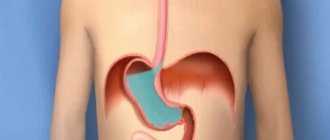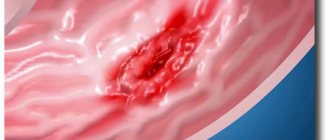The pylorus (pylorus) is located in the pylorus of the stomach, separates it from the duodenum, regulates the movement of food gruel, and is responsible for the transport of hydrochloric acid. Diseases of this organ cause disruptions in the functioning of the gastrointestinal tract, so when symptoms of pathology develop, complex therapy should be started. Treatment consists of taking medications, using traditional medicine, and proper dietary nutrition.
Structure of the stomach
Gatekeeper functionality
The functionality of the pylorus is associated with the evacuation of food liquid from the stomach and its portioned excretion into the duodenum. Dietary liquid, after being processed by gastric juice with digestive enzymes, enters through the pylorus in one direction - caudal. This is facilitated by peristaltic contractions of the longitudinal muscles of the stomach during relaxation of the pyloric sphincter muscles. When the circular muscles of the pylorus are tense, the smooth muscle fibers of the antrum, cardia and body of the stomach relax. This is how coordinated muscle work occurs, leading to the gradual evacuation of food mass from the digestive organ to the following sections of the digestive system. The opening and closing of the sphincter and mucous valve occurs with the dynamics of mechanical pressure.
The rate of evacuation of gastric contents will depend on several factors:
- The degree of filling of the stomach, the qualitative composition of the incoming food and the amount of hydrochloric acid, digestive enzymes, etc. secreted by the gastric cells.
- The degree of tension in the muscular layer of the pylorus and the condition of its mucosa, especially the posterior part.
- Acid-base balance, temperature and other physical parameters of the food bolus.
- Peristaltic function of the bulbar part of the duodenum and the volume of the intestinal ampulla that depends on it.
- The degree of threat of destruction of the mucous membrane of the distal intestine.
The acid-base balance has a direct impact on the work of the annular muscles of the pylorus. In the stomach, food is mixed with hydrochloric acid, which is necessary for the normal functioning of stomach enzymes. Approaching the opening of the pylorus, the acidic food bolus irritates the mucous membrane, causing the opening to expand. After hydrochloric acid enters the duodenal bulb, it neutralizes the alkaline content, which causes the closure of the mucosal valves and contraction of the sphincter muscles. A further increase in the alkaline balance occurs in the bulb; when the valves are closed, the next portion of the food bolus is formed in the stomach.
Pyloric obstruction
Complete emptying of the stomach occurs within 8 hours, light food is evacuated faster, heavy food – slower. Unabsorbed carbohydrates and water are the first to rush out of the stomach. Proteins undergo partial hydrolysis and therefore remain in the digestive organ longer. Fats are the last to leave the stomach.
The work of the pylorus is influenced by gastrin and other hormones secreted by endocrine cells of the stomach. Chemicals in the form of ethanol and glucose slow down the contraction of the pyloric muscles and have a strong irritating effect on the mucous membranes of the pylorus.
Use of folk remedies
Medical experts oppose the use of folk remedies as primary therapy. However, they can be used for additional treatment. But first you need to consult with your doctor so that he approves this or that traditional medicine recipe, taking into account the individual characteristics of the patient’s body and focusing on the results of diagnostic studies.
If the pylorus of the stomach does not close, you can use the following traditional medicine recipes:
- mix the herb St. John's wort, motherwort and valerian in equal proportions, then brew 1 tablespoon of the mixture in a glass of boiling water, the infusion is kept until completely cool, then filtered and used internally with honey;
- Squeeze the juice from fresh plantain leaves and take 1 teaspoon orally before meals during exacerbations of the disease;
- Juice is squeezed out of dandelion flowers and taken orally before meals.
In addition, in case of insufficiency of the pylorus of the stomach, decoctions of calamus root, caraway-based tincture and other medicinal drugs are taken.
Characteristics of pyloric diseases
As a result of a violation of the diet, pathologies of metabolism and regulatory mechanisms, the development of the following pylorus diseases is likely:
- benign neoplasms – polyps;
- narrowing of the pyloric canal – stenosis;
- ulcerative condition of the pylorus mucosa;
- long-term insufficiency of the gastrointestinal tract;
- spasm.
Stenosis
The cause of the development of pyloric stenosis is several reasons, among the most common is an ulcerative condition of the antral mucosa of the stomach. The consequences of narrowing the lumen of the canal (low patency of the food bolus) manifest themselves in the form of a feeling of heaviness in the stomach that occurs after eating food. Frequent vomiting and nausea, which do not ultimately bring relief to the patient’s condition, lead to the development of exhaustion and dehydration of the body. Discomfort in the stomach and frequent belching become constant companions of the disease.
Pyloric stenosis
Self-medication does not guarantee a successful result. First of all, they undergo a diagnostic examination and visit a gastroenterologist. If the diagnosis of “pyloric stenosis” is confirmed, the doctor may prescribe medications to reduce the secretory function of the digestive organ (ranitidine, pirenzipine and their analogues). In case of an ulcerative condition of the mucous membrane of the pyloric part of the stomach, drugs are prescribed to treat the ulcer (Phosphalugel, etc.). While monitoring the condition of the pylorus in the hospital, doctors periodically suck out the gastric contents. If dynamics of expansion of the pylorus are observed, in the future they try to limit the amount of food eaten.
Pyloric stenosis can be treated with a radical method if the effect of conservative treatment is not achieved. The operation is indicated for children with a congenital narrow lumen of the pylorus. Most often it is necessary to make an artificial pylorus with its implantation. Sometimes the affected pyloric section of the digestive organ is removed with the expansion of the pyloric canal.
Spasm
Spasm of the pylorus can occur for a number of reasons, which are independent diseases and characterize excessive tension in the annular muscles of the canal, leading to a long-term narrowing of its lumen. Among the reasons for the development of spasms are:
- ulcer of the antrum of the stomach;
- formation of polyps;
- deficiency of B vitamins;
- congenital spasmodic condition that poses a threat to the life of infants;
- gastritis;
- exposure to nicotine and tar in tobacco;
- pathologies in the regulatory system.
Therapeutic measures to eliminate pylorus spasms are:
- a balanced diet, excluding heavy, difficult to digest foods;
- treatment of the cause that caused the spasm;
- prescription of vitamins and mineral nutrition for exhaustion and dehydration;
- quitting smoking and eliminating strong experiences of psycho-emotional stress.
Polyps
Polyps are most often observed in the pylorus of the digestive organ and the pylorus. A diagnostic examination allows timely detection of the presence of polyps in only one case out of fifty examined.
Treatment of polyps can be carried out using an endoscope or in a radical way. During the operation, polyps are removed if they are single, or the entire section of the stomach is removed if they are multiple in the section. The risk of new formations occurring after surgery is high, so the patient is under observation for a long time.
Ulcer
Pyloric ulcer, based on clinical manifestations and chemical characteristics of the processes, is classified as duodenal ulcers, which are treated radically. Antacids do not have the same effect that is observed with stomach ulcers. The patient experiences severe pain in the epigastric region after eating.
Gatekeeper failure
The concept of “pyloric insufficiency” is used when the structure of the closure function is not fully performed, as a result of which the stomach evacuates the food mass too quickly. Pathology occurs in old age, as a consequence of inflammation in the stomach or due to the individual structure of the digestive organ.
The pathology is easily eliminated with conservative treatment and diet.
Therapeutic diet and nutritional recommendations
First of all, you need to eat small portions, but often, and also exclude certain foods from your diet. It is advisable to set a schedule for eating and eat it at the same time. It is not recommended to overload the digestive system, otherwise negative consequences and deterioration of the general condition are possible even with drug therapy.
Nutritional features for this pathology are as follows:
- After eating, it is important to remain in an upright position for at least two hours;
- the basis of the diet is liquid and semi-liquid food - low-fat soups and cereals;
- It is forbidden to eat fatty, fried and spicy foods;
- restrictions are imposed on chocolate, coffee;
- It is not recommended to eat foods with a high acid content, especially if there is a suspicion of an ulcer;
- carbonated drinks, including water, are excluded from the diet;
- You should remain slightly hungry after each meal.
Food consumed should be warm or at room temperature. It is unacceptable to eat food that is too hot or too cold. The last meal should be at least two hours before bedtime.
Prevention
In order to prevent the development of pylorus pathologies, it is recommended to follow the following recommendations:
- timely diagnosis and treatment of ulcers of various locations;
- rejection of bad habits;
- balanced diet;
- preventing evasion from periodic examinations;
- avoiding wearing tight clothing.
A person who strives to fulfill all instructions and understands the danger of neglect of the disease can quickly recover from these pathologies.
RepostTweet
Stages of the malignant process
Stages of stomach cancer according to the TNM system:
| Stage No. | T (primary tumor) | N (metastases in lymph nodes) | M (distant metastases) |
| 1A | T1 | N0 | M0 |
| 1B | T1, T2 | N1, N0 | M0, M0 |
| 2 | T1, T2 | N2, N1 | M0 |
| 3A | T2, T3, T4 | N2, N1, N0 | M0, M0, M0 |
| 3B | T3, T4 | N2, N1 | M0, M0 |
| 4 | T4, Any T | N2, Any N | M0, M1 |
Explanation:
T values (primary tumor):
- T1 – the tumor infiltrates the gastric wall to the submucosal layer.
- T2 – infiltration to the subserous membrane is observed. There may be invasion of the muscle layer, involving the gastrointestinal or gastrorenal ligament, greater or lesser omentum, without invasion of the visceral peritoneum.
- T3 – cancer has spread beyond the serous membrane (visceral peritoneum), but there is no damage to adjacent structures (spleen, transverse colon, abdominal wall and retroperitoneum, small intestine, adrenal glands, kidneys).
- T4 – germination into the adjacent structures indicated above.
Read here: Skin cancer on the back
N (metastases in lymph nodes):
- N0 – no metastases in lymph nodes.
- N1 – there are metastases in the perigastric lymph nodes no further than 3 cm from the edge of the primary tumor.
- N2 – extensive metastases in the perigastric lymph nodes or damage to nodes located along the left gastric, common hepatic, splenic or celiac artery.
M (secondary tumors in organs):
- M0 – no metastases.
- M1 – there are metastases in distant organs.
Causes
The causes of stomach cramps are poor diet, alcohol abuse, chronic gastritis, etc. All of them are divided into two groups: functional and organic.
Functional
They appear both without any pathology and together with it. Similar spasms occur in middle-aged people, schoolchildren, and students. Strongly related to lifestyle, ecology, emotional state. It happens that an obvious cause of functional disorders cannot be detected.
- The most common cause is prolonged stress.
- Lack of adequate nutrition.
- Genetic predisposition.
- Pathogen intoxication.
- Prolonged hypothermia.
- Vascular disorders in the abdominal cavity.
- Metabolic disorders.
- Alcoholism, smoking, excessive caffeine consumption.
- Some medications cause gastrointestinal spasms.
- Mechanical impact, rough food.
- Food allergic reactions.
- Accumulation of gases in the stomach.
- Parasitic infestation.
One of the reasons may be aerophagia - excessive swallowing of air when eating or talking.
There is such a thing as hunger pains (spasms), which, as you might guess, occur with prolonged refusal to eat. This is especially painful with ulcerative lesions. You can stop this condition by simply eating something. Interestingly, hunger pains originate in the brain; this is a signal from the body to a lack of food, and therefore energy for existence.
Functional disorders usually depend on the individual characteristics of the organism. Unfavorable factors can include neuroses, neurasthenia, and increased emotionality.
Organic
As a rule, they occur at older ages and imply organic changes in tissues. Often they are serious diseases in themselves:
- Gastritis. Occur at the moment of exacerbation, caused by the intake of spicy or sour foods. In severe episodes it is accompanied by vomiting.
- Peptic ulcer disease. Cramps appear after eating, especially provoking food or alcohol. Accompanying symptoms include heartburn and sour belching.
- Exacerbation of pancreatitis or pancreatic colic caused by alcohol or fatty foods. A rise in temperature is possible, then hospitalization and a full examination are advisable.
- Gastroduodenitis.
- Erosive lesions of the stomach walls.
- Imbalance of hydrochloric acid production.
One of the ways to determine the nature of the spasm is to intravenously or subcutaneously administer strong myotropic drugs (atropine, dibazole) to the patient. If the deformation of the stomach does not disappear with the help of medications, or does not disappear enough, most often this indicates an organic cause.
This is interesting: Oncologist Andrei Pavlenko died of stomach cancer. How to recognize it?
Preventive actions
You can prevent the development of pathology associated with the pylorus of the stomach if you adhere to the following recommendations.
- Get checked regularly. When the first signs appear, consult a doctor.
- Eat properly. Avoid processed foods, fast food and snacks, carbonated drinks and coffee.
- Avoid stressful situations and depression.
- Give up bad habits such as smoking and drinking alcohol.
- Avoid strenuous physical activity. Don't overeat. Don't eat at night.
Self-medication can lead to complications. Therefore, you should not postpone your visit to the doctor.
Treatment of gastric outlet cancer
For pyloric cancer, surgery is considered the main treatment method. Only with the help of radical therapy can a person’s life be saved. Most often, the operation is performed in combination with radiation or chemotherapy, which improves the quality of the operation and reduces the possibility of relapse of the disease.
Distal tumors should be treated with subtotal gastrectomy. Affected lymph nodes are also removed. The spleen and pancreas are removed only if there is direct invasion of these organs. Surgical treatment is the most important prognostic factor. Without it, a person has no chance of surviving to 5 years.
At the same time, radical operations for gastric cancer are associated with great risk, especially in advanced cases with severe stenosis. Another disadvantage is the lack of clear indications for subtotal gastrectomy.
Read here: What causes cancer?
Only stage 1, 2 and 3 tumors can be treated surgically. It is worth noting that due to the inconspicuous course of the disease and late visits to the doctor, most patients are admitted with advanced cancer. Therefore, only 50-60% of operations are carried out. Of these, radical resections are available for 40%.
Partial gastrectomy does not have the desired effect on the life expectancy of patients, but it helps to alleviate their serious condition. This approach is used only as palliative care and for older people. Also, to eliminate symptoms, a gastroenteroanastomosis is formed.
The most effective type of chemotherapy for stomach cancer is intraperitoneal chemotherapy. Pre- and postoperative cytostatic therapy is used less frequently. The most commonly used chemotherapy drugs are 5-fluorouracil, Cisplatin and Epirubicin. About 4 courses are prescribed, with an interval of several weeks between them.
Palliative treatment with chemotherapy may allow resection of previously unresectable tumors.
The use of radiation therapy for gastric cancer is poorly described in the literature, since it does not significantly affect long-term results. Radiation may be prescribed to unresectable patients to reduce tumors and relieve pain.
Symptomatic therapy includes pain relief, nausea, constipation, and oral care.
Main reasons
It is believed that the disease can be caused by any factors affecting the regulatory processes of the central nervous system, spinal cord, and local gastric network. In other words, any damage to the nervous system can provoke gastric atony.
Signs of atrophic gastritis of the stomach
The triggering factor may be:
- severe infectious diseases with severe intoxication (especially typical for typhoid fever, botulism);
- excessive stressful situations;
- previous myocardial infarction, peritonitis, lobar pneumonia;
- spinal and brain injury.
Gastric atony is detected in patients against the background of:
- frequent excessive overeating (overstretching of the stomach walls);
- exposure to toxic substances (toxins) due to food poisoning;
- exhaustion of the body;
- thrombosis of the feeding arterial vessels of the stomach;
- endocrine pathology, hormonal imbalance;
- damage to nerve trunks during gastric surgery;
- congenital changes in the form of prolapse and lengthening of the organ.
How is diagnosis carried out?
- radiography with contrast;
- fibrogastroduodenoscopy;
- ultrasonography;
- general blood and urine analysis;
- Magnetic resonance imaging;
- biochemical research.
If insufficient closure of the sphincter is detected, then muscle atony is possible.











